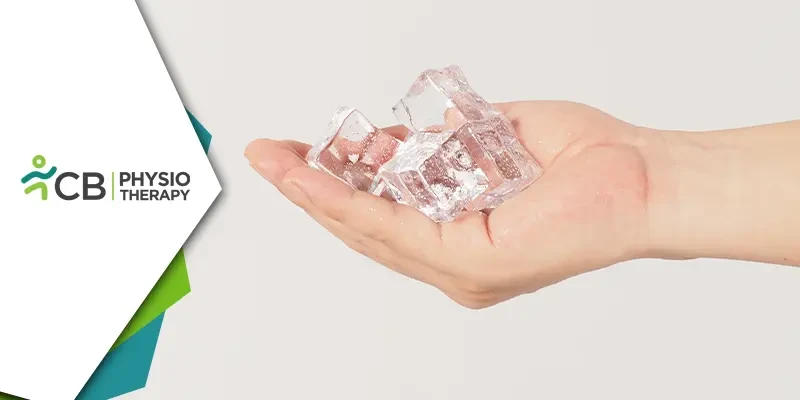Cryotherapy, or cold therapy, has long been a cornerstone in the realm of physiotherapy. This treatment involves the application of cold temperatures to an injured or inflamed area of the body. Used for centuries, cryotherapy has evolved from simple ice packs to sophisticated equipment like cryo chambers. This blog delves into how, why, and when cryotherapy is effective and recommended by physiotherapists for treatment purposes.
How Cryotherapy Works?
Cryotherapy operates on the principle of heat exchange. When cold is applied to the body, it causes vasoconstriction, the narrowing of blood vessels, which reduces blood flow to the affected area. This reduction in blood flow helps to minimize swelling and inflammation. Additionally, the cold temperature numbs the nerve endings, which provides pain relief.The most common methods of cryotherapy include:
1: Ice Packs and Cold Compresses: These are the most accessible forms of cryotherapy. They are applied directly to the skin and are effective for localized treatment.2: Ice Baths: Athletes often use ice baths to reduce muscle soreness and speed up recovery after intense exercise.
3: Cryo Chambers: These involve standing in a chamber with extremely cold air (-110 to -140 degrees Celsius) for a few minutes. This method is becoming increasingly popular in sports and rehabilitation centers.
Why Cryotherapy is Effective?
1. Reduction of Inflammation and SwellingInflammation is a natural response to injury, but excessive inflammation can lead to prolonged pain and delayed healing. Cryotherapy effectively reduces inflammation by constricting blood vessels, thereby limiting the flow of inflammatory mediators to the injured area. This reduction in swelling and inflammation accelerates the healing process.
2. Pain Relief
Cold therapy is an excellent analgesic. By numbing the affected area, cryotherapy interrupts the transmission of pain signals to the brain. This pain relief is particularly beneficial for acute injuries, such as sprains and strains, as well as for chronic conditions like arthritis.
3. Decreased Muscle Spasms
Muscle spasms often accompany injuries, adding to the pain and discomfort. Cryotherapy helps in reducing muscle spasms by decreasing the metabolic rate of the muscle tissue and altering the activity of the motor neurons.
4. Enhanced Recovery Post-Exercise
Cryotherapy is a popular recovery tool. After intense physical activity, muscles can become sore and inflamed. Ice baths and cryo chambers are used to mitigate this soreness and speed up recovery, helping maintain a high level of performance.
When Cryotherapy is Recommended?
Cryotherapy is versatile and can be used in various stages of injury and recovery:1. Acute Injuries
For acute injuries, such as sprains, strains, and bruises, cryotherapy is usually recommended within the first 48 hours. The primary goals during this stage are to reduce inflammation, minimize swelling, and provide pain relief. Applying an ice pack or cold compress for 15-20 minutes every hour can significantly aid in managing these symptoms.
2. Post-Surgical Recovery
After surgery, cryotherapy is often used to manage pain and swelling. It helps to decrease the need for pain medications, which can have undesirable side effects. Physiotherapists might use cold therapy in conjunction with other treatments to enhance recovery and improve mobility.
3. Chronic Conditions
Conditions like osteoarthritis, rheumatoid arthritis, and chronic tendonitis can benefit from cryotherapy. Regular sessions can help manage chronic pain and inflammation, improving the quality of life for patients.
4. Rehabilitation Exercises
During the rehabilitation phase, cryotherapy can be used post-exercise to reduce muscle soreness and inflammation. This is particularly useful for patients undergoing rigorous physical therapy routines aimed at restoring strength and mobility.
5. Recovery
Frequently used cryotherapy as part of their training regimen. Cold baths and cryo chambers help reduce muscle fatigue and soreness after intense workouts or competitions, promoting quicker recovery times and enhancing overall performance.
Role of Cryotherapy in Physiotherapy Treatment
Physiotherapists play a crucial role in the effective use of cryotherapy. They assess the patient’s condition and determine the appropriate cryotherapy method and duration. Here’s how they ensure optimal results:1: Assessment and Diagnosis: Physiotherapists evaluate the injury or condition to determine if cryotherapy is suitable. This involves understanding the type of injury, its severity, and the patient's overall health.
2: Customized Treatment Plans: Based on the assessment, physiotherapists design a tailored treatment plan that may include cryotherapy along with other therapeutic modalities such as massage, electrical stimulation, or exercise.
3: Monitoring and Adjusting Treatment: Throughout the treatment, physiotherapists monitor the patient’s response to cryotherapy and make necessary adjustments. They ensure the cold therapy is applied correctly to avoid issues like frostbite or cold burns.
4: Education and Guidance: Physiotherapists educate patients on how to safely use cryotherapy at home. They provide instructions on the duration and frequency of ice pack applications and caution against overuse.
5: Safety Considerations: While cryotherapy is generally safe, certain precautions need to be taken to avoid adverse effects:
6: Duration and Frequency: Applying ice for too long can cause skin damage, frostbite, or nerve damage. It’s important to limit the application to 15-20 minutes at a time, with breaks in between.
7: Barrier Protection: Always place a cloth or towel between the ice pack and skin to prevent direct contact, which can lead to ice burns.
8: Pre-existing Conditions: Individuals with certain conditions, such as Raynaud's disease, cold allergies, or cardiovascular issues, should avoid cryotherapy unless advised otherwise by the physiotherapist.
Cryotherapy is a powerful tool in the arsenal of physiotherapists, offering significant benefits in reducing inflammation, alleviating pain, decreasing muscle spasms, and enhancing recovery. Its effectiveness across various stages of injury and recovery makes it a versatile and essential treatment modality. However, it should always be used under the guidance of a trained physiotherapist to ensure safety and optimal outcomes. As research continues to evolve, the applications and benefits of cryotherapy in physiotherapy are likely to expand, offering even more avenues for effective treatment and rehabilitation.

